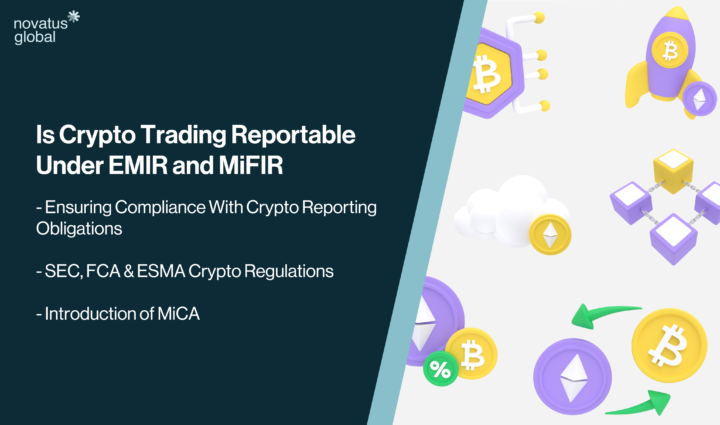
The mainstream adoption of cryptocurrency over the past decade has led to varied interpretations of whether crypto trading falls under regulatory reporting obligations. Once perceived as a type of “Wild West” currency for the unbanked, crypto has evolved into a popular asset class with widespread facilitation on mainstream financial platforms. This has led to an increase in interest from not only retail investors, institutional investors, financial services firms and brokers but also from regulators.
Regulators like the Securities Exchange Commission (SEC) in the US, the Financial Conduct Authority (FCA) in the UK and the European Securities and Markets Authority (ESMA) in the EU have dedicated significant resources to establishing which crypto products should comply with derivative reporting rules.
The introduction of the Markets in Crypto-Assets (MiCA) regulation by ESMA aims to clarify and classify how crypto-assets are treated. On 29 April 2024, the EMIR Refit clarified reporting field for crypto-assets under the regulation. On 30 September 2024, the FCA reciprocated this message under the UK EMIR Refit, providing equivalent clarity to UK financial markets.

EMIR Refit and Its Application to Crypto-Assets
Since its introduction in 2012, the European Market Infrastructure Regulation (EMIR) has been revised multiple times to adapt to evolving markets. Despite these changes, its core objective remains the same – to improve market transparency and reduce systemic risk by establishing reporting and risk management obligations for derivatives trading within EU financial markets.
Under the EMIR Refit, financial services firms operating within EU and UK markets must report detailed information for each derivative transaction. This requirement now includes crypto-assets, provided they meet the definition of a “derivative” or a “derivative contract”. This classification aligns crypto-asset derivatives with traditional derivatives like equity or commodity derivatives.
Furthermore, the EMIR Refit also states that if a crypto-asset qualifies as a “financial instrument” under the Markets in Financial Instruments Directive II (MiFID II), it must also be reported under EMIR. This ensures that crypto-assets are subject to the same reporting standards as other derivatives.
The Introduction of a New Reporting Field
The EMIR Refit 2024 introduced a new reporting field labelled 2.12 “Derivative based on crypto-assets” to allow for the reporting of crypto-asset derivatives. This field requires firms to indicate whether the underlying asset of a derivative is a crypto-asset, by marking the field as “True”.
The addition of this new field enables regulators to:
- Monitor trading volumes and exposure related to crypto derivatives
- Accurately assess and manage the risks associated with the increased use of crypto-assets in financial markets
- Gain deeper insights into market activity relating to crypto-assets
The introduction of this new field reflects the growing recognition of crypto-assets within the broader financial system. It also further aligns EMIR with global initiatives aimed at establishing consistent regulatory standards for crypto derivatives.
MiFIR and Crypto Reporting Obligations UK & EU
Under UK MiFIR, reporting obligations apply when a crypto-asset or its derivative is traded on a trading venue located in the UK, Gibraltar or the EU. This ensures that transactions involving crypto-assets are reported according to the same standards as traditional financial instruments.
Similarly, EU MiFIR imposes reporting obligations for crypto-assets and their derivatives traded on venues within the European Economic Area (EEA). These obligations are important for enhancing transparency and providing regulators with the data needed to monitor crypto trading effectively.
By extending MiFIR reporting obligations to include crypto-assets, both the EU and the UK have demonstrated their commitment to considering crypto markets within the larger regulatory framework. This represents a positive step forward in aligning crypto markets with traditional financial market standards.
What Are the Implications of Non-Compliance for Crypto Reporting?
Failing to meet crypto reporting obligations under EMIR and MiFIR can result in serious consequences for firms, including both monetary and non-monetary penalties. Article 12 of EU EMIR states, “Member states shall lay down the rules on penalties applicable to [EMIR reporting] infringements and shall take all necessary measures to ensure they are implemented.” This means that EU member states have the authority to enforce penalties and the size of these penalties can vary between jurisdictions.
France currently holds the highest EMIR-enforceable fine within the EU, with a maximum fine of €10 million. Non-compliance can also lead to other outcomes for the firm such as reputational damage or increased regulatory scrutiny. Ensuring timely and accurate reporting is essential for mitigating these risks and maintaining trust with regulators.
How Can Firms Ensure Compliance with Crypto Regulation
Since crypto reporting is still a relatively new requirement, many firms may face challenges in understanding how to fulfil their reporting obligations.
Novatus En:ACT is the purpose-built SaaS platform developed to ensure firms meet their global reporting requirements without the need for ongoing remediation programmes.
En:ACT offers full G20 coverage and is both scalable and compatible with existing technology, structures and processes.
Get in touch today and a member of our team will be happy to showcase how En:ACT can streamline your crypto reporting obligations.
Crypto Regulatory Reporting FAQs
The three main types of crypto derivatives are futures, options and perpetual contracts (a type of futures contract without an expiry date).
Crypto spot trading does not fall under the reporting obligations of EMIR or MiFIR. This is because spot trades do not classify as derivatives since they involve the immediate or near-immediate delivery of an asset, which excludes them from EMIR reporting obligations.
Similarly spot trading does not involve financial instruments in the MiFIR sense, as they represent an immediate purchase or sale of an asset for cash. This means they are not reportable under MiFIR.
A Contract for Difference (CFD) is an agreement between a buyer and seller to exchange the difference in the open and close value of a financial product. They are treated slightly differently under EMIR and MiFIR:
EMIR:
-
-
- CFDs are considered OTC derivates and must be reported
-
MiFIR:
-
-
- Crypto-assets are not reportable unless the underlying asset is traded on a venue within the EEA or UK
- There are presently no venue-listed cryptocurrencies in these jurisdictions, so crypto-assets generally fall outside the scope of MiFIR
- However, If a cryptocurrency is listed on an EEA or UK venue in the future, any CFDs on those assets would be reportable under both MiFIR and EMIR.
-











